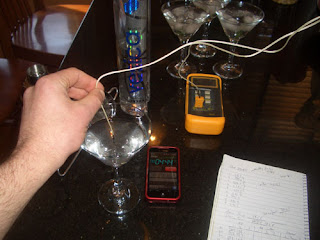While it is always stressed that chilling glassware is an important step in making great drinks, how important is that to the end result? Moreover, some bars will cool their glassware in freezers while others will chill them with melting ice or ice water. While obviously the freezer is more optimal, how does that difference translate into the final drink temperature? To test that, I devised an experiment to address these questions using a Vodka "Martini" as a standard drink.
Materials:
• 30 oz Vesica Vodka (80 proof)
• 9 Libbey Martini Glasses
• Freezer
• Cobbler Shaker
• Fine Strainer
• OXO Measuring Cup
• Ice from Tovolo Trays from Freezer
• Digital Thermometer with Thermocouple (-58°F to 2372°F, ±0.1°F)
• Timer Application on Droid Phone
• Digital Scale
Protocol:
• Measure room temperature and freezer temperature.
• Chill 3 glasses in freezer for over 90 minutes.
• Chill 3 glasses with ice cubes with some water.
• Measure temperature of ice water before use.
• Keep 3 glasses at room temperature.
• Add 3 oz vodka and 4 ice cubes to cobbler shaker. Shake 30 seconds.
• Double strain to remove ice shards.
• Measure temperature every 30 seconds for 5 minutes while gently stirring with temperature probe.
• Ice water dumped 15 seconds before straining. Glasses removed from freezer 15 seconds before straining.
• Do a round of shaking to measure initial temperature before straining.
 Caveats:
Caveats:
• Yes, I shook a Vodka "Martini" but it is a quicker technique than stirring and is a consistent method. Moreover, taste and texture of the drink were unimportant here.
• Different glass sizes and shapes will affect the end result. Here, the 9 glasses are comparable to each other, but not to other glasses.
• Ice temperature (from freezer or wet ice) will affect results.
• Room temperature will affect results.
• Different drink compositions will change the amount of alcohol, sugar, and other solutes in the drink and may effect temperatures.
• My thermometer was never calibrated.
• Initial temperature (t=0) was only measured once as a separate experiment. Performing it for each run would have disrupted the experiment. This data point is only there as rough estimate for each trial's initial time point.
• Glasses were not handled or drank from (which would otherwise normally happen).
Data:
• Average Glass Weight: 237.4 grams (range 231.1-244.3 grams)
• Room Temperature: 59.1°F
• Freezer Temperature: 13.1°F
• Ice Water Temperature: 33.6°F
• Vodka (shaken for 30 seconds) Temperature: 24.9°F
• Data presented as average of triplicate runs:

Average Temperature (30-300 seconds):
• Room Temperature Glass: 31.0°F
• Ice Water Chilled Glass: 29.1°F
• Freezer Chilled Glass: 26.6°F
Differences in Average Temperature (30-300 seconds):
• Room Temp - Ice Water: 1.9°F
• Room Temp - Freezer: 4.4°F
• Ice Water - Freezer: 2.5°F
Differences in Temperature at 30 & 60 seconds:
• Room Temp - Ice Water: 1.2 & 1.7°F
• Room Temp - Freezer: 2.7 & 3.8°F
• Ice Water - Freezer: 1.6 & 2.1°F
Conclusions:
Initial temperature of the glassware before straining does effect the temperature of the drink. The freezer-chilled glassware provided the coldest drinking experience but only provided a drink that was 2.5°F colder than an ice water-chilled glass in this experiment. The freezer-chilled and ice water-chilled glassware were better than unchilled glassware by 4.4°F and 1.9°F, respectively, over the time course. The differences, however, were not as great in magnitude when the first sip might be taken (somewhere between 30-60 seconds after straining).
Choice of glassware would matter greatly. In a cocktail glass, the stem and base do not play a large role, whereas in a rocks glass, the thick base would act as a large heat sink. Moreover, freezers will chill the whole glass whereas ice water will mainly chill the cocktail glass' bowl. Future experiments could address these difference such as by measuring the temperature time courses of coupes and rocks glasses as well as different styles of cocktail glasses.
So what does a 1, 2, or 4 degree difference mean to the perception of a drink? Obviously, this will vary by drink composition and some drinks will be only slightly less pleasant to drink warmer whereas others' balance will begin to crumble. Over the 5 minute time course, an unmolested drink changed about 3 degrees in this experiment. Perhaps making the same drink twice, strained 5 minutes apart and sampled simultaneously, would help to answer that.
Be sure to read the other experiments:
• Part 2: Kinetics of Glass Cooling
• Part 3: Effects of Glass Thickness on Drink Temperature





 1 1/2 oz Blended Scotch (Famous Grouse)
1 1/2 oz Blended Scotch (Famous Grouse)




















 My goal was to make an aromatic bitters that would work great in anything Abbott's or even Angostura does but particularly dark spirits drinks like rye, Cognac, and aged rum. Since I had a lot of new botanicals from the Abbott's Bitters recipe and it would be months before that batch was ready, I took influence from it,
My goal was to make an aromatic bitters that would work great in anything Abbott's or even Angostura does but particularly dark spirits drinks like rye, Cognac, and aged rum. Since I had a lot of new botanicals from the Abbott's Bitters recipe and it would be months before that batch was ready, I took influence from it, 











 1 1/2 oz Plymouth Gin
1 1/2 oz Plymouth Gin


 The 2017 collection of 855 drink recipes, bartender tributes, and essays on hospitality from CocktailVirgin's Frederic Yarm. Available at
The 2017 collection of 855 drink recipes, bartender tributes, and essays on hospitality from CocktailVirgin's Frederic Yarm. Available at  The 2012 collection of 505 drink recipes, techniques, and Boston bar recommendations from Frederic Yarm. Available at
The 2012 collection of 505 drink recipes, techniques, and Boston bar recommendations from Frederic Yarm. Available at 




